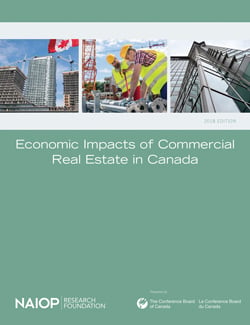The Northern Influence of Commercial Real Estate

The industry’s impact on Canada is the focus of a new NAIOP research report.
Many commercial real estate professionals won’t make a deal unless they can pencil it out on a single piece of paper first. That means they require access to accurate information — about property values, tax rates, interest rates and much more. But in a world of instant (and sometimes incorrect) data, accurate information is becoming even more vital.
Every January, NAIOP releases “Economic Impacts of Commercial Real Estate,” a report by Stephen Fuller, Ph.D., of George Mason University in Arlington, Virginia. It has become a reliable resource for CRE professionals as well as policymakers in Washington and state capitals who use it to understand the contributions commercial real estate makes to the U.S. economy. It provides a state-by-state look at the number of jobs generated and supported by the CRE industry.
Now, NAIOP is turning north of the border to provide a similar service for the Canadian economy.
Canadian Commercial Real Estate Creates Thousands of Jobs
A recent report, prepared by the Conference Board of Canada for the NAIOP Research Foundation, estimates the impact of commercial real estate development along three measures of economic activity in that country: gross domestic product (GDP, or value-added), employment and labor income. The Conference Board of Canada does not lobby for specific interests and is funded exclusively through the fees charged for services to the private and public sectors.
The report finds that in 2017, commercial real estate investment in Canada totaled $38.6 billion. That money supported:
- $40.2 billion in gross domestic product (GDP)
- $25.2 billion in labor income
- $10.1 billion in government revenues
In Canada, spending on CRE also supports more than 400,000 jobs, roughly three percent of the population.
In a similar vein, every $1 million spent on commercial real estate nationwide supports 10.8 workers. Of course, the value on investment varies by province. In Alberta, a total of 8.5 jobs are supported across the economy for every $1 million invested. Further east, in Quebec, every $1 million spent on commercial real estate generates 12 jobs.
The majority of CRE investment is in building structures. Actual construction costs account for more than 60 percent of commercial real estate spending, some $25 billion nationwide in 2017 (the most recent year for which full information is available). “Soft construction costs account for the next highest share at $5.3 billion, followed by interior buildout ($4.9 billion), and site development and infrastructure ($3.7 billion),” the report adds.
‘Clearly Positive’
The trend in CRE investment is moving strongly in the right direction, and far outpacing the overall rate of growth in the Canadian economy. “Growth in commercial real estate spending was exceptionally strong during the mid-2000s but has slowed somewhat in recent years. However, the long-term trend is clearly positive, with aggregate commercial real estate spending rising by 36 per cent, or $10 billion a year, since 2007,” the report found.
Meanwhile, the overall economy is thought to have expanded just 2.0 percent in 2018 (final numbers are not available yet). That growth rate is a drop from 2017’s 3.0-percent expansion. Looking ahead, the report projects only 1.8-percent expansion in each of the next two years. Thus, CRE should remain a bright spot in the Canadian economy.
One place the country has room to grow is outside its major cities.
“Together, Canada’s six largest cities, or census metropolitan areas (CMAs), accounted for close to 60 per cent of all commercial real estate spending in the country in 2017,” the report finds. “The largest city, Toronto, accounted for one-fifth of total commercial real estate spending alone.” The other CMAs are Vancouver, Calgary, Edmonton, Ottawa-Gatineau and Montreal.
But the report adds that some economic activity does tend to spill across provincial borders, highlighting the “truly national impact that commercial real estate makes on the Canadian economy, regardless of where the investment actually occurs.”
Not surprisingly, the provinces that spend more on CRE tend to see a greater impact. “Consequently, approximately 40 per cent of GDP and labour income accrues to Ontario, followed by 18 per cent to both Alberta and Quebec, and 11 percent to British Columbia,” the report finds. This tracks with their overall provincial investment in CRE.
The report is sure to become a must-read on Parliament Hill in Ottawa and throughout the provinces as well, where it can help NAIOP’s Canadian chapters in their meetings with policymakers. To help provide a steady stream of information, NAIOP plans to publish a similar study every two years going forward. It will be interesting to watch the impact of CRE across time and across borders.
Rich Tucker is NAIOP’s director for public policy communications.
Get the Report
Economic Impacts of Commercial Real Estate in Canada, 2018 Edition |



